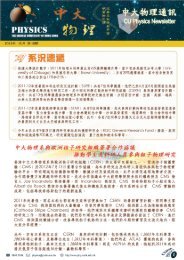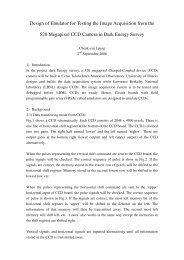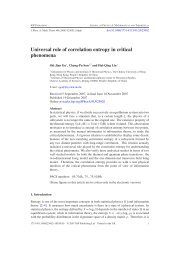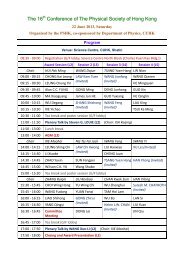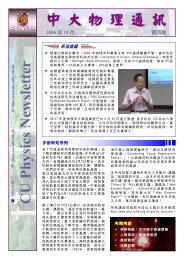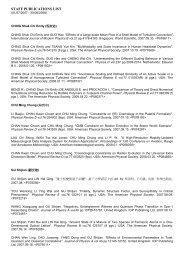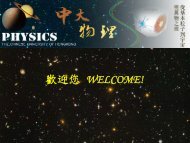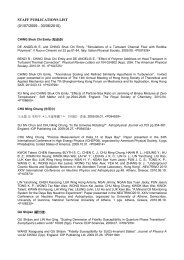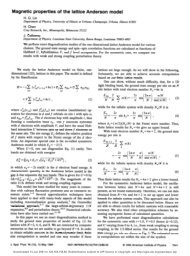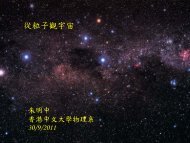Phonon-mediated superconducting transitions in layered cuprate ...
Phonon-mediated superconducting transitions in layered cuprate ...
Phonon-mediated superconducting transitions in layered cuprate ...
Create successful ePaper yourself
Turn your PDF publications into a flip-book with our unique Google optimized e-Paper software.
PHONON-MEDIATED SUPERCONDUCTING TRANSITIONS…<br />
by the <strong>in</strong>terlayer coupl<strong>in</strong>g, which is naturally responsible for<br />
the CuO 2 layer dependence of the isotope effect. There have<br />
been very few reports of isotope measurements <strong>in</strong> thalliumand<br />
mercury-based materials. The predictions made here for<br />
await further experimental studies.<br />
VIII. CONCLUSIONS<br />
We have developed a phonon-<strong>mediated</strong> d-wave BCS-like<br />
model for <strong>layered</strong> copper-oxide superconductors. The homologous<br />
series of HgBa 2 Ca n−1 Cu n O 2n+2+ has been chosen<br />
as a model system to <strong>in</strong>vestigate the <strong>superconduct<strong>in</strong>g</strong> transition<br />
features. We have shown that once the band structure<br />
and symmetry features are considered, this model can account<br />
well for the magnitudes of both the <strong>superconduct<strong>in</strong>g</strong><br />
transition temperatures and oxygen isotope exponents as<br />
functions of dop<strong>in</strong>g level and number of CuO 2 layers. We<br />
have found that this theoretical model also reproduces the<br />
CuO 2 layer dependence of the pressure effect, isotope effect,<br />
and lattice distortion effect <strong>in</strong> typical Hg-based <strong>cuprate</strong>s.<br />
Thus, all known dist<strong>in</strong>ct effects on T c <strong>in</strong> <strong>cuprate</strong>s have been<br />
<strong>in</strong>terpreted with<strong>in</strong> the present s<strong>in</strong>gle theoretical framework.<br />
We also have found that the theoretical model works well for<br />
other homologous series such as the Bi-based and Tl-based<br />
families. We have concluded that the <strong>in</strong>terlayer coupl<strong>in</strong>g<br />
PHYSICAL REVIEW B 75, 134504 2007<br />
plays an important role <strong>in</strong> the enhancement of T c and <strong>in</strong> the<br />
systematic reduction of <strong>in</strong> a <strong>layered</strong> homologous series.<br />
Some results of the calculations are certa<strong>in</strong>ly only <strong>in</strong> qualitative<br />
agreement with the experimental data, and a much<br />
better agreement could be obta<strong>in</strong>ed by adjust<strong>in</strong>g the model<br />
parameters for each <strong>in</strong>dividual compound. However, the<br />
model is only <strong>in</strong>tended to describe experimental trends rather<br />
than to reproduce all the data accurately. Many predictions<br />
have been made and hence await experimental exam<strong>in</strong>ation.<br />
In spite of the simplicity and the limitations of the model, the<br />
results strongly suggest the role of the phonons should be<br />
<strong>in</strong>cluded <strong>in</strong> any real microscopic mechanisms <strong>in</strong> expla<strong>in</strong><strong>in</strong>g<br />
the <strong>superconduct<strong>in</strong>g</strong> behavior of <strong>cuprate</strong>s. Very recently, we<br />
have demonstrated 103 that the variation of amongst various<br />
optimally doped <strong>cuprate</strong>s is controlled by the effective nextnearest-neighbor<strong>in</strong>g<br />
hopp<strong>in</strong>g. The oxygen isotope effect on<br />
the <strong>superconduct<strong>in</strong>g</strong> transition is also found to resemble the<br />
effect of pressure on the transition.<br />
ACKNOWLEDGMENTS<br />
This work at Carnegie was supported by the Department<br />
of Energy Grant No. DEFG02-02ER4595, and CDAC Grant<br />
No. DEFC03-03NA00144. One of the authors, H. Q. L., was<br />
supported by the Hong Kong RGC Group Research Grant<br />
No. HKU3-05C.<br />
1 Z. Tešanović, Phys. Rev. B 36, 2364 1987.<br />
2 J. M. Wheatley, T. C. Hsu, and P. W. Anderson, Nature London<br />
333, 121 1988.<br />
3 J. L. Birman and J. P. Lu, Phys. Rev. B 39, 2238 1989.<br />
4 A. Sudbø, J. Low Temp. Phys. 97, 403 1994.<br />
5 K. Byczuk and J. Spałek, Phys. Rev. B 53, R518 1996.<br />
6 A. J. Leggett, Phys. Rev. Lett. 83, 392 1999.<br />
7 L. Jansen and R. Block, Physica A 293, 465 2001.<br />
8 X. J. Chen and H. Q. L<strong>in</strong>, Phys. Rev. B 69, 104518 2004; 71,<br />
109901E 2005.<br />
9 M. Di Stasio, K. A. Müller, and L. Pietronero, Phys. Rev. Lett.<br />
64, 2827 1990.<br />
10 E. M. Ha<strong>in</strong>es and J. L. Tallon, Phys. Rev. B 45, 3172 1992.<br />
11 X. J. Chen, Z. A. Xu, Z. K. Jiao, and Q. R. Zhang, Phys. Lett. A<br />
229, 247 1997.<br />
12 A. Trok<strong>in</strong>er, L. LeNoc, J. Schneck, A. M. Pougnet, R. Mellet, J.<br />
Primot, H. Savary, Y. M. Gao, and S. Aubry, Phys. Rev. B 44,<br />
2426 1991.<br />
13 A. P. Howes, R. Dupree, Z. P. Han, R. S. Liu, and P. P. Edwards,<br />
Phys. Rev. B 47, 11529 1993.<br />
14 Z. P. Han, R. Dupree, R. S. Liu, and P. P. Edwards, Physica C<br />
226, 106 1994.<br />
15 K. Magishi, Y. Kitaoka, G.-q. Zheng, K. Asayama, K. Tokiwa, A.<br />
Iyo, and H. Ihara, Phys. Rev. B 53, R8906 1996.<br />
16 H. Kotegawa, Y. Tokunaga, K. Ishida, G.-q. Zheng, Y. Kitaoka,<br />
H. Kito, A. Iyo, K. Tokiwa, T. Watanabe, and H. Ihara, Phys.<br />
Rev. B 64, 064515 2001.<br />
17 H. Kotegawa, Y. Tokunaga, K. Ishida, G.-q. Zheng, Y. Kitaoka,<br />
A. Iyo, Y. Tanaka, and H. Ihara, Phys. Rev. B 65, 184504<br />
2002.<br />
18 X. J. Chen, Z. A. Xu, J. S. Wang, Z. K. Jiao, and Q. R. Zhang,<br />
Chem. Phys. Lett. 258, 11996.<br />
19 X. J. Chen, Z. A. Xu, Z. K. Jiao, and Q. R. Zhang, Ch<strong>in</strong>. Phys.<br />
Lett. 14, 221 1997.<br />
20 Q. R. Zhang and X. J. Chen, Physica C 282-287, 905 1997.<br />
21 W. G. Y<strong>in</strong> and C. D. Gong, Phys. Rev. B 57, 11743 1998.<br />
22 X. J. Chen and C. D. Gong, Phys. Rev. B 59, 4513 1999.<br />
23 G. G. N. Angilella and R. Pucci, Physica B 265, 136 1999.<br />
24 S. Chakravarty, H. Y. Kee, and K. Völker, Nature London 428,<br />
53 2004.<br />
25 T. A. Zaleski and T. K. Kopeć, Phys. Rev. B 71, 014519 2005.<br />
26 H. Kotegawa, Y. Tokunaga, Y. Araki, G.-q. Zheng, Y. Kitaoka, K.<br />
Tokiwa, K. Ito, T. Watanabe, A. Iyo, Y. Tanaka, and H. Ihara,<br />
Phys. Rev. B 69, 014501 2004.<br />
27 H. Mukuda, M. Abe, Y. Araki, Y. Kitaoka, K. Tokiwa, T. Watanabe,<br />
A. Iyo, H. Kito, and Y. Tanaka, Phys. Rev. Lett. 96,<br />
087001 2006.<br />
28 M. Mori and S. Maekawa, Phys. Rev. Lett. 94, 137003 2005.<br />
29 V. G. Hadjiev, X. J. Zhou, T. Strohm, M. Cardona, Q. M. L<strong>in</strong>, and<br />
C. W. Chu, Phys. Rev. B 58, 1043 1998.<br />
30 S. J. Hwang, J. H. Choy, and N. H. Hur, Phys. Rev. B 57, 1259<br />
1998.<br />
31 A. Lanzara, P. V. Bogdanov, X. J. Zhou, S. A. Keller, D. L. Feng,<br />
E. D. Lu, T. Yoshida, H. Eisaki, A. Fujimori, K. Kishio, J. I.<br />
Shimoyama, T. Noda, S. Uchida, Z. Hussa<strong>in</strong>, and Z.-X. Shen,<br />
Nature London 412, 510 2001.<br />
32 T. Cuk, F. Baumberger, D. H. Lu, N. Ingle, X. J. Zhou, H. Eisaki,<br />
N. Kaneko, Z. Hussa<strong>in</strong>, T. P. Devereaux, N. Nagaosa, and Z.-X.<br />
134504-9



